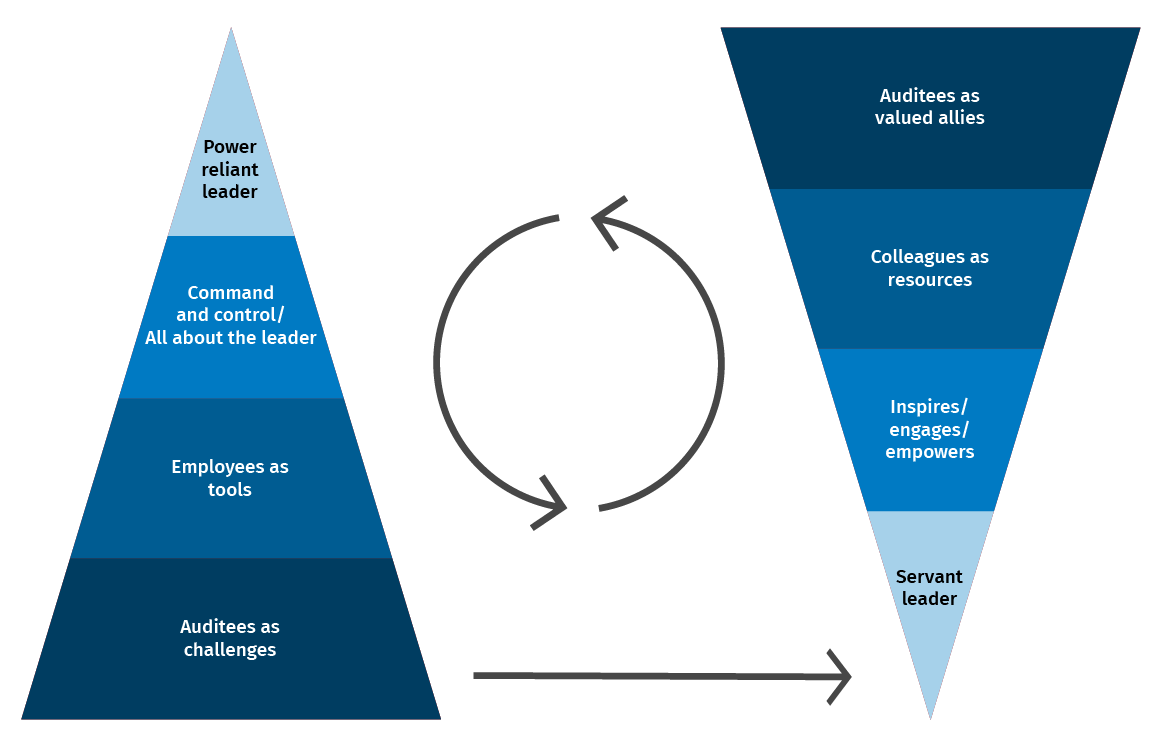We also explored in greater detail the first two characteristics – business alignment and internal audit stakeholder relationship management. In this next installment, we examine and discuss characteristic #3 – empowering leadership – and the individual components that include servant leadership, investing in personal growth, and embracing diversity and inclusion:
- Servant leadership
- Investing in personal growth
- Diversity and inclusion
Servant leadership
Highly effective internal audit functions have operating models that look to reduce the distance between the top of the function – the Chief Audit Officer (CAO) – and the auditors working on the ground, every day, with the auditees. They reduce the layers of ‘management’ between the CAO and the ‘customer’ of the audit function. A rule of thumb often applied here in larger functions is no more than 5/6 layers of reporting hierarchy in the organization with the CEO being layer 1, CAO layer 2, Head of Audit layer 3 etc. However, I would challenge all internal audit functions to operate with no more than 4 layers to reduce the layers of reporting and the inevitable distance this creates between the CAO and the day-to-day work of the function.
Operating with less layers of management and control requires management to take on a greater number of direct reports. To succeed, they must embrace a servant leadership approach. Many businesses operate a rule of thumb that suggests the average number of reports each manager in the hierarchy should have is at least 8 (sometimes referred to as the span of control). This is a useful guide, but it should not be applied in a prescriptive manner as teams will clearly differ. Are you able to achieve this on an average basis?
This servant leadership approach flips the traditional hierarchical structure on its head. A servant leader focuses primarily on the growth and well-being of people and the teams to which they belong. While traditional leadership generally involves the accumulation and exercise of power by one at the top of the pyramid, servant leadership is different. The servant leader shares power, places the needs of others first, and helps them develop and perform at their highest levels.
When operating a servant leadership approach, functions look to flatten their organizations and empower their employees to make decisions to keep up with a fast-moving business environment. Leaders are there to lend support, remove barriers, provide supplies, and, when necessary, even run errands. They also help when things go wrong, facilitating an open and educational approach to mistake management. All of this allows leaders to manage a greater number of direct reports. The principle here is simple — a reduction in management empowers employees to do the work that is needed at the front line. For nearly every manager, this requires unlearning previous approaches to managing their teams.

Investing in personal growth
High performance internal audit functions are continually investing in their skills and competencies. This is mandatory, and not a choice. The businesses we are auditing are moving fast and if we are not up to date, we are no longer relevant. Key skills that I am currently seeing organizations focus on are:
- Technology savviness – Exploring the full range of technology available to increase the impact of the internal audit work. This includes collaboration tools, data visualization capabilities, artificial intelligence, and, of course your core audit software, such as TeamMate+.
- Data analytics - The ability to collect, analyze, and interpret large amounts of data is now an expectation of all internal auditors.
- Communication and stakeholder engagement - Skills and techniques that deliver on the seamless stakeholder experience, discussed in more detail throughout the second article of this series.
- Agile - The ability to move quickly, adapt to new approaches in the moment, and engage stakeholders successfully in real time throughout the audit process.
- Business skills and knowledge – Building the knowledge of your business, its products, operations, and the markets it operates in to truly be able to explore the key risks and necessary controls.





